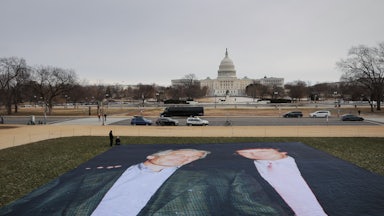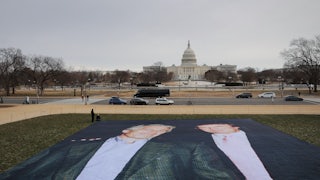It seems like every week now brings new written accounts and harrowing videos of federal agents—mostly from Immigration and Customs Enforcement, or ICE, but also from the ATF, DEA, FBI, and other federal agencies detailed to Trump’s all-encompassing immigration crackdown—engaging in what a worried public increasingly sees as police state tactics. Tufts Ph.D. student Rümeysa Öztürk was swarmed by agents, some masked, who took her away without presenting identification or a warrant, over her writing of a critical op-ed in a student newspaper. Agents have been filmed breaking car windows or, just this past week, waiting in immigration court in plainclothes and masks to detain immigrants whose cases had been unexpectedly dismissed.
In the wake of each of these operations, there’s the expected (and intended) community panic and the chill of fear among immigrants nationwide. But along with these feelings of alarm come a set of practical questions that observers pose over and over: Don’t these people need to present warrants, especially to bust someone’s car window? Don’t they need to identify themselves, give a name and badge number, something to that effect? How can anyone be sure these often anonymous figures, carrying out what are presumably orders from the administration, are even agents at all? What guarantee do we have that they have a legal basis to detain any given person, or that the person they’re detaining is the one they were looking for? Are they supposed to do this? Are they allowed?
These are, unfortunately, not necessarily clear-cut questions, in part because this pattern of behavior is relatively new. Immigration enforcement agents have long conducted so-called at-large arrests out in the community, but what we’ve seen in these first few months of Trump’s second term is the exception. Most ICE arrests historically have taken place in detention settings, such as local jails, often through the cooperation of local authorities.
Now it seems that the agency is intent on shows of force out in the community. As Mark Fleming of the National Immigration Justice Center noted, officers are now apparently going after not just people with final orders of removal but those who haven’t even been through any criminal or immigration process, using ICE-issued administrative warrants. “It feels like there’s something different going on that is deeply troubling. The covering of faces and the level of escalation of use of force in these encounters, that feels like there has been a permissiveness, a change in policy,” Fleming said.
A lot of what people confuse for targeted ICE operations are also actually Customs and Border Patrol immigration checkpoints, which the agency is allowed to set up within 100 air miles of any external boundary, encompassing several states and about two-thirds of the U.S. population (an expansiveness the executive branch gave itself via regulation, since the statute only specifies “reasonable distance”).
Under the law, ICE, CBP, and other immigration agents are generally empowered to warrantlessly question people about their right to remain in the United States and to arrest those who they have “reason to believe” are in violation of immigration laws, in cases where they believe the person is likely to escape before a warrant can be obtained—that is, a flight risk. Naturally, this does not override the Fourth Amendment, and what constitutes a reason for a stop or an arrest has been extensively litigated.
Most famously, in 1975, the Supreme Court issued a decision in U.S. v. Brignoni-Ponce, a case stemming from Border Patrol’s discovery that Puerto Rican–born Felix Brignoni-Ponce was transporting two undocumented immigrants, after it stopped them based largely on, as agents admitted, their “Mexican appearance.” The 9–0 majority opinion, written by Justice Lewis Powell Jr., ruled that it was unconstitutional for agents to use perceived race as a reasonable basis for a stop but then immediately defanged itself by allowing agents to consider a laundry list of factors in tandem, including “the characteristic appearance of persons who live in Mexico, relying on such factors as the mode of dress and haircut.” In effect, SCOTUS gave the green light for racial profiling as long as it incorporated a variety of factors not limited to just race alone.
Emma Winger, deputy legal director at the American Immigration Council, said a lot of the very public operations seemed to ignore the flight risk requirement. “Someone who says, ‘Please don’t arrest me, my kids are at home.’ ‘Please don’t arrest me, I’m going to pick up my kids,’ or, ‘My wife will come,’ the sorts of things people say when they’re arrested, there are reasons to think this person, in fact, has community ties,” she said.
Fleming, of the NIJC, has been involved in long-standing litigation that has challenged several aspects of how agents conduct both warrantless and warranted arrests in the Chicago area. In the case of Castaño Nava v. DHS, the legal group presented evidence that agents had, among other things, not heeded the flight risk requirement and racially profiled people improperly. That resulted in a settlement that required agents to take into account whether immigrants they sought to warrantlessly arrest “have community ties, so folks that have a home, have families, have gainful employment, are long-term residents ... if they have those sorts of ties to the community, there is not probable cause for their arrest,” Fleming said. The settlement only applied to the Chicago field office but was adopted as policy by ICE nationally.
Still, in most of the recent viral videos, it does not appear that agents are trawling for arrests. Rather, they are targeting specific people, for which they would need warrants. Now these aren’t warrants as most people would typically understand them—that is, those signed by a judge. ICE (for its civil immigration enforcement, separate from its criminal enforcement focuses) very rarely has judicial warrants in hand. Instead, it uses administrative warrants signed by supervisor agents in the agency itself. These don’t allow agents to enter nonpublic areas of private property (there’s an exception in the law for patrolling within 25 miles of a border), such as houses and apartments. But these warrants do allow them to arrest individual people on sidewalks and in cars.
The NIJC is now litigating questions about these warrants, including how agents present them during operations. “When they’re making those arrests based on an administrative warrant in a public space, they need to serve, physically serve the warrant on the individual promptly upon arrest. That is something they clearly are not doing,” said Fleming. “I don’t think there’s any true guidance as to showing the warrant. So, for example, you see videos [of bystanders] like, ‘Show us the warrant. Show us the warrant.’ As to the individual being arrested, they definitely need to serve the warrant as a matter of law.”
The group is also alleging that agents are filling out blank warrants after they’ve already conducted arrests in order to get around the terms of the earlier settlement. In practice, that means agents don’t necessarily have to show the warrant to witnesses but must serve an existing warrant to the target.
As for the agents themselves, there don’t seem to be any specific federal laws or regulations that would prevent them from wearing plainclothes; ICE agents are not an inherently uniformed force and rarely wear uniforms outside of specialized units like ICE Strategic Response Teams—which are effectively the agency’s SWAT division. Ditto face coverings; obviously, there was a period during the pandemic when federal employees were encouraged or even directed to wear face coverings. Now there’s no guidance that explicitly prohibits or discourages it.
Some critics—including Virginia Senators Mark Warner and Tim Kaine in a recent letter to DHS Secretary Kristi Noem, immigration coordinator Tom Homan, ICE acting Director Todd Lyons, and D.C. Field Office Director Russell Holt—have pushed ICE to have agents identify themselves, under federal regulations that purportedly require it. The trouble is, these regulations specify that an agent will “as soon as it is practical and safe to do so … identify himself or herself as an immigration officer who is authorized to execute an arrest.” Not only can they argue that an active arrest does not make this practical, but what it means to identify themselves as an immigration officer is unclear. Does just saying, “I’m an immigration officer” count? That hasn’t been conclusively settled either way.
Those same regulations also require agents to use “the minimum non-deadly force” to effectuate an arrest, a regulation with which Winger of the AIC doesn’t believe they’re complying. “It’s true that the protections are less for motor vehicles than they are for homes, but the Fourth Amendment still applies to those kinds of stops, and it certainly seems in the examples that I’m aware of that ICE is very eager to use that show of force where it seems evident that it’s not necessary,” she said.
Congress has taken some recent stabs at beefing up requirements for federal agents to identify themselves. Tucked into the nearly 1,500-page 2021 National Defense Authorization Act—the annual military funding behemoth bill—was a provision requiring armed forces or federal law enforcement to individually and visibly display “the individual’s name or other individual identifier” and the branch or agency they worked for. Unfortunately, the provision only applies to agents responding to “civil disturbances” and creates an exception for agents who already “do not wear a uniform or other distinguishing clothing or equipment in the regular performance of their official duties,” making it rather toothless.
Where this leaves us is that there’s no single, clean answer to whether agents’ conduct is strictly legal in each of these operations. Some bits are evidently unlawful, though the arrests as a whole have some legal basis. Yet, as Fleming argues, “the law is a floor. The law is not where we should be; that is the floor of what’s required.… I am reluctant to comment on whether [the conduct] is within the bounds of law, because it makes it sound like it’s a permissible way of exercising the awesome authority of the federal government, and it’s wholly inappropriate how they’re going about this. None of these individuals pose any public safety risk.”
The salient point is that while we tend to consider these things from the standpoint of basic legality, the matter of whether any given action is strictly legal is only one part of the question. The new and apparently reflexive practice to cover faces by default may not run afoul of any particular laws or regulations, but it does rightly offend our sense that law enforcement operates under some public scrutiny and constraint and that the people tasked with wielding the awesome power of a state monopoly on lawful violence should be identifiable.
Speculation over whether right-wing militias or other groups who can easily buy a tactical vest and an “ICE” patch off eBay could use this confusion to themselves snatch people off the street is valid and worth raising, but perhaps the more pressing question is the inverse one: What does it mean when official federal law enforcement agents from multiple agencies are tasked with carrying out a heavy-handed mission of dubious legality and with questionable tactics? As I pointed out in the wake of Mahmoud Khalil’s arrest, this is all the natural result of a national security state allowed to reach its logical conclusion. It’s now up to a stultified Congress and fractured courts to put the genie back in the bottle, if they can.










